its paid sponsors, whose products you need!
“Stay ‘unreasonable.’ If you
don’t like the solutions [available to you], come up with your
own.”
Dan Webre
The Martialist does not
constitute legal advice. It is for ENTERTAINMENT
PURPOSES ONLY.
Copyright © 2003-2004 Phil Elmore, all rights
reserved.
Fight with Light
By Phil Elmore
If you don’t have a tactical light, all the
other urban warriors will laugh at you and make fun of you. You will be
branded as an incompetent by the tactical establishment. Black-clad
ninja will leap from the shadows at the first opportunity and you will be
powerless in the murky darkness. Your family and friends will be forced
to live with the shame of your poorly lighted demise.
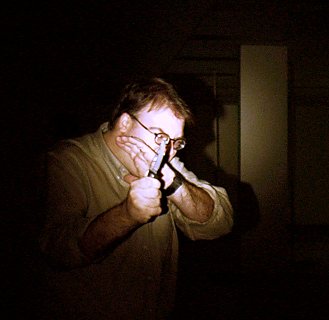
Blind! Blind, I say! I am helpless before
tactical lighting!
Okay, now that
we’ve gotten all that silliness out of the way, we can dismiss the equally
silly literature that promotes tactical lights as generators of
eyeball-searing, blinding pure whiteness that burns assailants dead with a
flick of your righteous thumb on a tailcap switch. Tactical lights are
extremely useful and if you do not own one you should. This does not
mean they are magical wands of pupil-contracting justice. They are,
however, yet another means of stacking the odds in your favor in an
altercation. In any low-light condition, the ability to put bright light
where and when you want it for the minimum duration necessary is a definite
advantage.
There are many lights on the
market. Selecting one is outside the scope of this article. Know
simply that you should own a small but very bright light that has a tailcap
pressure switch. Most of the suitable lights on the market use Xenon
bulbs (SureFire, Streamlight, etc), but there are a few suitable LED lights
available too.
In daylight or lighted
room conditions, must tactical lights are unpleasant and mildly distracting if
one stares into them. I don’t know that I would consider them
debilitating, however. Any serious blinding or distraction value these
lights have, then, occurs primarily in low- or no-light conditions. Any
physical striking techniques (using the light as a pressure stick or fist
load) obviously apply regardless of environmental illumination.
LIGHT ALONE
When
your only weapon is the light, it can be used alone to augment your fighting
style as both fist load and pressure stick. I prefer the posture shown
below, in which the light is held in a reverse hammer grip as part of a
modified guard that protects the centerline.
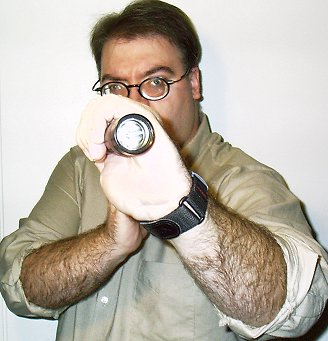
One posture for hand-to-hand fighting with a
flashlight.
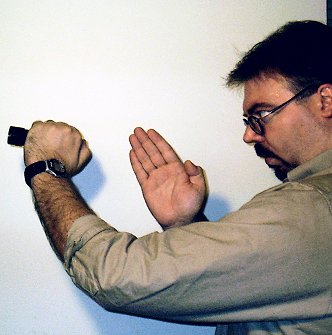
The same posture seen from the side.
From this posture, the head of the light can be slammed into
vulnerable points on the assailant’s body (eyes, throat, and the backs of the
hands, primarily) or the light can be activated and used to flash the
attacker’s eyes.
Maintaining light in the
opponent’s eyes while striking and otherwise dominating that opponent is a
useful way to increase your chances of overwhelming that opponent. If
you’re striking with the light, your ability to use it as a distracter is
curtailed by the jerking of the light or by damage it may incur during
striking.
I think of the use of
maintained light while fighting as something like pointing one’s sword (or
knife, in some styles) at the opposing duelist’s eyes. The theory in the
case of the blade is that this makes your sword harder to see and track.
With the light, I don’t believe you can count on your tactical torch
intimidating your opponent or otherwise reducing him to a cringing, blind,
helpless bundle. Chances are, however, that a maintained burst of bright
light will make it harder for him to fight you.
LIGHT AND WEAPON
Using
hte light in combination with an edged or impact weapon follows the same
principles as when using it to augment otherwise empty-hand defense. The
light becomes an extension of the off hand, used to flash the opponent’s eyes
when opportunity in allows in concert with the strikes from the light and the
primary weapon. I prefer a light-forward posture when using just the
light, but this will shift when using the light with a baton or knife.
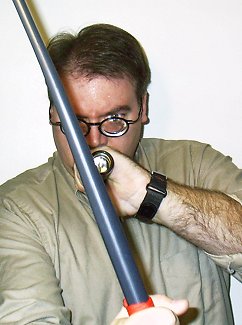
Light and sjambok striking tool. The
primary weapon comes forward.
One
caveat that applies to using the light alone and with weapons is that of
targeting. Specifically, in low light the torch is a beacon that allows
assailants to target you. This cannot be helped. If you
want to use the light you have to accept that is a momentary liability when
used. Tailcap switches (and hence the use of intermittent light) help
diminish the risk. When maneuvering in low light prior to contact with
an opponent, always light-and-move, getting quickly out of each new target
zone you create when you flash the light. SureFire literature I’ve read
on low light fighting recommends varying the height and angle of your flashes
to further confuse enemies.
Using a
tactical light with a firearm helps you identify and acquire targets in low
light. The light may also blind or distract a hostile individual,
against whom you are justified in using lethal force. Entire books have
been written addressing armed combat in low light, so we’re really just
scratching the surface here. Your primary task, though, is to learn to
wield the light in conjunction with the handgun.
I say handgun because this is the scenario most private
citizens will face: using their personal defense firearm in low-light
conditions to protect their families and themselves. If you can legally
obtain a handgun for home defense, do so. There is no better tool.
There are four basic postures, well known in the “gun culture”
and used for low-light shooting. These are the Harries, Ayoob, Chapman,
and Rogers postures.
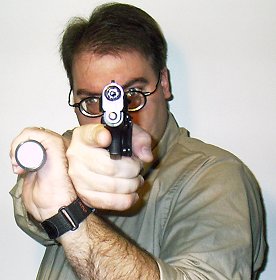 |
HARRIES POSTURE
This is the |
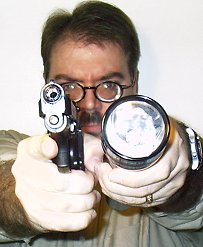 |
AYOOB POSTURE
The gun hand holds In recent SureFire tactical literature, Massad Ayoob himself |
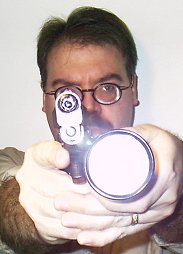 |
CHAPMAN POSTURE
This technique |
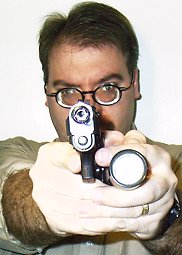 |
ROGERS POSTURE
This is a two-hand |
To effectively engage hostiles using a handgun and light, you
ought to seek out qualified range instruction. There are numerous
factors to consider apart from target identification and acquisition.
These include the reaction of the assailant to your light, the possibility
that he’ll shoot you when you light him up, the appropriate tactics for moving
through dark structures while scanning with your light, and even the
possibility that you will face opponents who have lights of their own.
These are beyond the scope of this article.
The information presented here will get you started. It
provides some basic principles with which you can work and practice. The
rest, however, is up to you and those with whom you train.
It is human nature to fear darkness. About 80% of our
sensory input is visual, which means the risk of any low-light encounter is
dramatically increased. Technology has given us the means to bring light
to the darkness. You cannot afford not to master these tools.
Fight with light to walk more safely in darkness.
